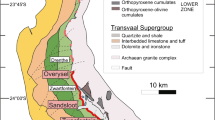Abstract
The major platinum-group elements (PGE) concentrations in layered intrusions are typically associated with zones in which the sulfide abundance begins to increase. In a number of layered intrusions, there is also a distinct stratigraphic separation in the peak concentrations of the PGE from those of the base metals, gold and sulfur through these zones. These stratigraphic “offsets” are characterized by a lower, typically S-poor, Pt- and Pd-enriched zone overlain by a zone enriched in the base metals, S and Au. The separations amount to a few decimeters to several tens of meters. In some instances, the high Pt and Pd concentrations are associated with trivial amounts of sulfide. Theoretical considerations suggest that these offsets can be modeled as chromatographic peaks that develop during an infiltration/reaction process. Using Pd as a typical PGE and Cu as a typical base metal, a numeric model is developed that illustrates how metal separations can develop in a vapor-refining zone as fluid evolved during solidification of a cumulus pile leaches sulfide and redeposits it higher in the crystal pile. The solidification/degassing ore-element transport is coupled with a compaction model for the crystal pile. Solidification resulting from conductive cooling through the base of the compacting column leads to an increasing volatile concentration in the intercumulus liquid until it reaches fluid saturation. Separation and upward migration of this fluid lead to an upward-migrating zone of increasingly higher bulk water contents as water degassed from underlying cumulates enriches overlying, fluid-undersaturated interstitial liquids. Sulfide is resorbed from the degassing regions and is reprecipitated in these vapor-undersaturated interstitial liquids, producing a zone of relatively high modal sulfide that also migrates upward with time. Owing to its strong preference for sulfide, Pd is not significantly mobile until all sulfide is resorbed. The result is a zone of increasing PGE enrichment that follows the sulfide resorption front as solidification/degassing continues. In detail, the highest Pd concentrations occur stratigraphically below the peak in S and base metals. The high Pd/S ratio mimics values conventionally interpreted as the result of high (silicate liquid)/(sulfide liquid) mass ratios (“R” values). However, in this case, the high Pd/S ratio is the result of a chromatographic/reaction front enrichment and not a magmatic sulfide-saturation event.
Similar content being viewed by others
Author information
Authors and Affiliations
Additional information
Received: 13 April 1998 / Accepted: 5 October 1998
Rights and permissions
About this article
Cite this article
Boudreau, A., Meurer, W. Chromatographic separation of the platinum-group elements, gold, base metals and sulfur during degassing of a compacting and solidifying igneous crystal pile. Contrib Mineral Petrol 134, 174–185 (1999). https://doi.org/10.1007/s004100050477
Published:
Issue Date:
DOI: https://doi.org/10.1007/s004100050477




